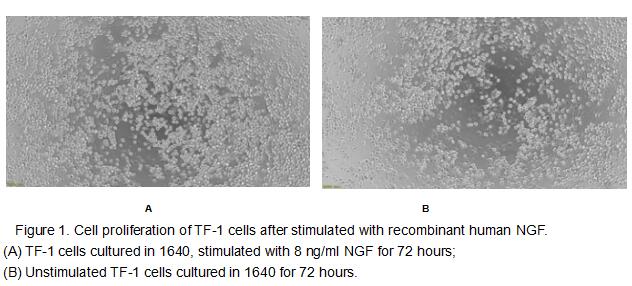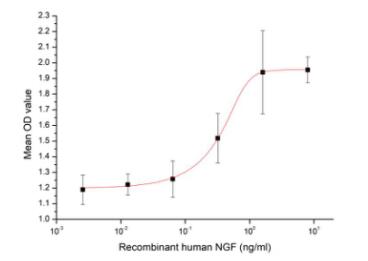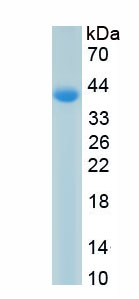Active Nerve Growth Factor (NGF) 

NGFB; Beta-NGF; HSAN5; NGF-B; Beta-Nerve Growth Factor
- UOM
- FOB US$ 241.00 US$ 603.00 US$ 1,206.00 US$ 3,618.00 US$ 9,045.00
- Quantity
Overview
Properties
- Product No.APA105Hu61
- Organism SpeciesHomo sapiens (Human) Same name, Different species.
- ApplicationsCell culture; Activity Assays.
Research use only - DownloadInstruction Manual
- CategoryCytokineNeuro science
- Buffer FormulationPBS, pH7.4, containing 5% Trehalose.
- Traits Freeze-dried powder, Purity > 95%
- Isoelectric Point9.9
Sign into your account
Share a new citation as an author
Upload your experimental result
Review

Contact us
Please fill in the blank.
Activity test

Nerve growth factor (NGF) is a neurotrophic factor and neuropeptide primarily involved in the regulation of growth, maintenance, proliferation, and survival of certain target neurons. To test the effect of NGF on cell proliferation, TF-1 cells were seeded into triplicate wells of 96-well plates at a density of 20,000 cells/well with various concentrations of recombinant human NGF. After incubated for 72 hours, cells were observed by inverted microscope and cell proliferation was measured by Cell Counting Kit-8(CCK-8). Briefly, 10 µl of CCK-8 solution was added to each well of the plate, then the absorbance at 450 nm was measured using a microplate reader after incubating the plate for 1-4 hours at 37℃. Proliferation of TF-1 cells after incubation with NGF for 72 hours observed by inverted microscope was shown in Figure 1. Cell viability was assessed by CCK-8 (Cell Counting Kit-8 ) assay after incubation with recombinant human NGF for 72 hours. The result was shown in Figure 2. It was obvious that recombinant human NGF significantly increased cell viability of TF-1 cells, the EC50 was 0.38 ng/ml.

Figure 2. Cell proliferation of TF-1 cells after stimulated with recombinant human NGF.
Usage
Reconstitute in 10mM PBS (pH7.4) to a concentration of 0.1-1.0 mg/mL. Do not vortex.
Storage
Avoid repeated freeze/thaw cycles. Store at 2-8°C for one month. Aliquot and store at -80°C for 12 months.
Stability
The thermal stability is described by the loss rate. The loss rate was determined by accelerated thermal degradation test, that is, incubate the protein at 37°C for 48h, and no obvious degradation and precipitation were observed. The loss rate is less than 5% within the expiration date under appropriate storage condition.
Increment services
-
 BCA Protein Quantification Kit
BCA Protein Quantification Kit
-
 Molecular Mass Marker for Protein
Molecular Mass Marker for Protein
-
 Monoclonal Antibody Customized Service
Monoclonal Antibody Customized Service
-
 Polyclonal Antibody Customized Service
Polyclonal Antibody Customized Service
-
 Protein Activity Test Experiment Service
Protein Activity Test Experiment Service
-
 Electrophoretic Mobility Shift Assay (EMSA) Experiment Service
Electrophoretic Mobility Shift Assay (EMSA) Experiment Service
-
 Buffer
Buffer
-
 Lentivirus Packaging Experiment Service
Lentivirus Packaging Experiment Service
-
 Adenovirus Packaging Experiment Service
Adenovirus Packaging Experiment Service
-
 Real Time PCR Experimental Service
Real Time PCR Experimental Service
-
 Spike RBD Protein (S-RBD)
Spike RBD Protein (S-RBD)
-
 Protein G
Protein G
-
 Protein A
Protein A
Citations
- Low-intensity aerobic exercise mitigates exercise-induced bronchoconstriction by improving the function of adrenal medullary chromaffin cells in asthmatic ratsPubmed:25212248
- Neurotrophic and antioxidant effects of silymarin comparable to 4-methylcatechol in protection against gentamicin-induced ototoxicity in guinea pigsPubmed:25445537
- NGF and HB-EGF: Potential Biomarkers that Reflect the Effects of Fesoterodine in Patients with Overactive Bladder SyndromePubmed:25510766
- High glucose upregulates CYP24A1 expression which attenuates the ability of 1,25(OH)2D3 to increase NGF secretion in a rat Schwann cell line RSC96Pubmed:25614971
- High glucose upregulates CYP24A1 expression which attenuates the ability of 1,25(OH)2D3PubMed: 25614971
- Telmisartan inhibits hyperalgesia and inflammatory progression in a diabetic neuropathic pain model of Wistar rats.PubMed: 25864063
- Pro-apoptotic Action of Corticosterone in Hippocampal Organotypic CulturesPubmed:27189478
- Chronic mild stress influences nerve growth factor through a matrix metalloproteinase-dependent mechanismPubmed:26771945
- Changes in growth factor levels in the cerebrospinal fluid of autism patients after transplantation of human umbilical cord blood mononuclear cells and umbilical cord-derived mesenchymal stem cellsPubmed:27323064
- Differential expression of cord blood neurotrophins in gestational diabetes: the impact of fetal growth abnormalitiespubmed:28081639
- An Intranasal Formulation of Erythropoietin (Neuro-EPO) Prevents Memory Deficits and Amyloid Toxicity in the APPSwe Transgenic Mouse Model of Alzheimer's …articles:journal-of-alzheimers-disease
- Evaluación de la secreción de factores neurotróficos por las células MSV en cocultivo con neurorretinas porcinas, en función de la dosis celular y del tiempo de cultivo10324/27440
- Antidepressant drugs for beta amyloid-induced depression: A new standpoint?pubmed:28499898
- Mechanical loading of intervertebral disc modulates microglia proliferation, activation, and chemotaxisPubmed:29723636
- Autophagy is required for human umbilical cord mesenchymal stem cells to improve spatial working memory in APP/PS1 transgenic mouse modelPubmed:29335016
- N-3 PUFA diet enrichment prevents amyloid beta-induced depressive-like phenotypePubmed:29203442
- Preterm umbilical cord blood derived mesenchymal stem/stromal cells protect preterm white matter brain development against hypoxia-ischemiaPubmed:30012511
- Effects of n-3 PUFA enriched and n-3 PUFA deficient diets in naïve and Aβ-treated female ratsPubmed:30028991
- 3‐‐Laurylglyceryl ascorbate improves the development of sensitive skin through the reduction of oxidative stressPubmed: 30698879
- Administration of Repetitive Transcranial Magnetic Stimulation Attenuates Aβ1-42-Induced Alzheimer's Disease in Mice by Activating β-Catenin Signaling
- A novel xeno-free culture system for human retinal pigment epithelium cellsPubmed: 31024807
- Involvement of neurotrophic signaling in doxorubicin‑induced cardiotoxicityPubmed: 32010279
- Inhibition of Receptor for Advanced Glycation End Products as New Promising Strategy Treatment in Diabetic RetinopathyPubmed: 32165929
- Hyperlipidemia Down‐Regulate Brain Antioxidant Defense Enzymes and Neurotrophins in Rats: Assessment of the Modulatory Potential of EPA+ DHA and …Pubmed: 32918393
- Impaired LTD-like motor cortical plasticity in female patients with major depression disorderPubmed: 32791084
- Effects of gold nanoparticles administration through behavioral and oxidative parameters in animal model of parkinson's diseasePubmed: 32777662
- Neurobiological determinants of depressive-like symptoms in rodents
- Changes of substance P, NGF and CGRP salivary levels among patients undergoing physical therapy
- Multiple-component dual-phase solid lipid nanoparticles with conjugated transferrin for formulating antioxidants and nerve growth factor against neuronal apoptosis
- Increased serum brain-derived neurotrophic factor and adrenocorticotropic hormone levels are associated with obsessive compulsive disorder in medication?free?¡33389158
- Neuroprotective effect of Na+/H+?exchangers isoform©\1 inactivation against 6©\hydroxydopamine©\induced mitochondrial dysfunction and neuronal apoptosis in Parkinson's disease models33538000
- Sea urchin gangliosides exhibit neuritogenic effects in neuronal PC12 cells via TrkA- and TrkB-related pathways33589896
- Repetitive Transcranial Magnetic Stimulation Improves Mild Cognitive Impairment Associated with Alzheimer's Disease in Mice by Modulating the miR-567 …34239303
- Carissa macrocarpa Leaves Polar Fraction Ameliorates Doxorubicin-Induced Neurotoxicity in Rats via Downregulating the Oxidative Stress and Inflammatory Markers34959705
- CNTs‐CaP/chitosan‐coated AZ91D magnesium alloy extract promoted rat dorsal root ganglia neuron growth via activating ERK signalling pathway34296452
- Gene delivery of chitosan-graft-polyethyleneimine vectors loaded on scaffolds for nerve regenerationPubmed:35550777







